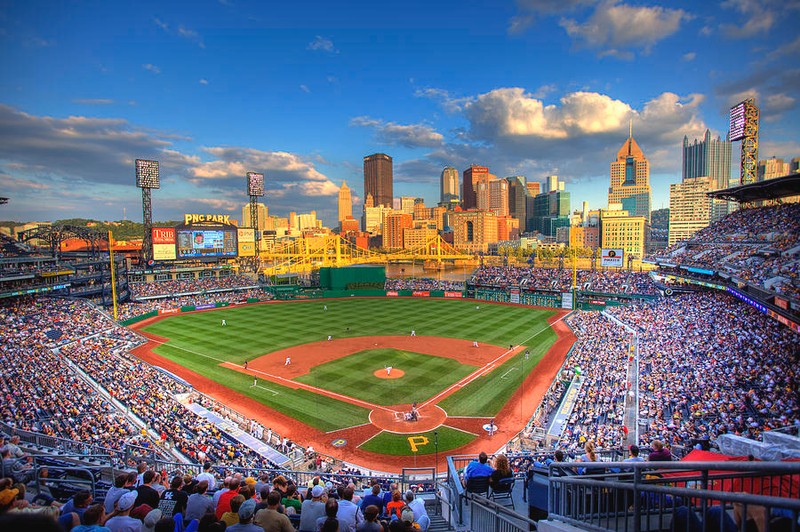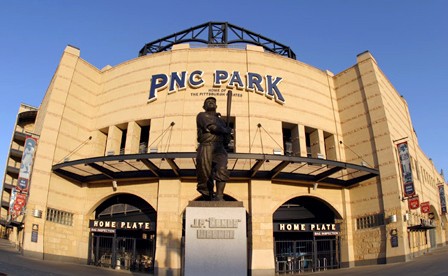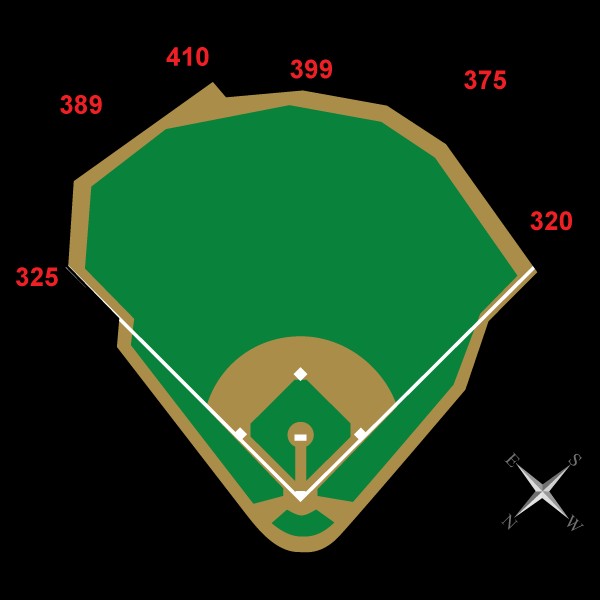PNC Park
Introduction
Text-to-speech Audio
Images
PNC Park opened on April 9, 2001, and took the place of the Pirates old home, Three Rivers Stadium.

PNC Park is home to the Pittsburgh Pirates major league baseball franchise.

Irregular Shape of Field

Backstory and Context
Text-to-speech Audio
PNC Park is home to the Pittsburgh Pirates Major League Baseball franchise. In the early 1990’s the Pirates were put up for sale by the owners. In attempts to not lose the city's baseball team the new mayor, Tom Murphy, put together a group to buy the Pirates in order to keep them in the city. But before they could buy the Pirates, they were required by MLB to build a new stadium that they did not have to share with the Steelers. In response, the group hired the architecture firm HOK, now known as Populous, to design and build a field. HOK wanted to create a field that emulated Pittsburgh, so they spent time before designing to see the city and visit all the local favorites.
The location was also very important to the architects, PNC Park was picked to be built on the North Shore of Pittsburgh, next to the Allegheny River and also overlooks downtown Pittsburgh and the Roberto Clemente bridge, creating a stunning view from the batter's box. The team also picked to have their dugout placed on the third base side, typically the home team is placed on the first base sideline, so they could have to best view in the house.
PNC Park is one of the smallest baseball parks with a capacity of 38,362 people. Intimacy was the goal of the architects which is why they only have two seating decks, the highest seats are only eighty-eight feet from the field. This ensured that everyone in the stadium would have a good view of the field.
The actual architecture of the ballpark was modeled after classic ballparks, especially after Forbes Field. Before the Pirates moved to Three Rivers Stadium they lived at Forbes Field for sixty-one seasons. They incorporated dark blue seats similar to those from Forbes Field and added tall light posts that rose above the park just as Forbes had. To bring a touch of Pennsylvania’s nature into the park they placed Indiana county rhododendrons, Norway pines, and mountain laurels in center field with shrubs that spell out Pirates. To remind visitors that Pittsburgh is the Steel City, the structure of the park is made of visible blue steel beams. The outside of the park had a limestone facade with terracotta tiled pilasters.
The park offers many places to hang out before, during, or after the games. The stadium is filled with restaurants, bars, and the river walk. The river walk is located behind the outfield wall, which is accessible during the game to though with tickets. Concession stands, picnic tables, and benches are placed along the walk allowing fans to enjoy the game or the view of downtown. On non-game days the river walk is open to the public.
To fund this impressive stadium proved to be more of a task than designing the park. Pittsburgh had been in an economical spiral in 1970-1980 when people were leaving Pittsburgh, businesses were going under, and the unemployment rate had reached double digits. As a result, building the ballpark was not popular with the public since the city could not pay for necessary things like fixing the roads. When the major proposed to increase the taxes to pay for the new stadium, it was quickly rejected. The final approved financial plan was 70% of the financing would come from the state, county, and city funding; while 30% would come from private funding. The Pirates franchise put $40 million into the funding. The final cost of PNC Park was $216 million. In 1998, PNC bank bought the naming rights for $2.2 million each year until 2020.
One of the unique things about PNC Park is how it interacts with the city of Pittsburgh and its dedication to past players. During home games, the Roberto Clemente bridge closes. This allows visitors and people of Pittsburgh to use the bridge as a walkway. During the construction of the ballpark, fans were given the chance to buy bricks and put personalized messages on them, which were then placed in the courtyard in the front of the stadium. They wanted the park to be more than just a baseball stadium, they wanted it to be apart of the Pittsburgh culture.
To pay homage to their history, there are multiple spots in the stadium to honor past players. On the spiral ramp in left field, it is lined with enlargements of baseball cards from some of the best Pirates players in history. To commemorate members of the Negro National League, they created Legacy Square which holds eight large fiberglass bats with names of sixteen former Negro League players like Satchel Paige. Throughout the stadium, they have five statues to honor some of their greatest players. Honus Wagner, Roberto Clemente, Willie Stargell, Ralph Kiner, and Bill Mazerozski.
Roberto Clemente is one of the most visible past players at PNC Park. Clemente was the Pirates right fielder from 1955 to 1972. In the 1960s he led the national league in batting average four times. He won other batting titles and lead the league in hits twice during his career. Not only was he a threat at the plate, by also was feared by runners when anything was hit to right field. Before his death, he helped the Pirates win the 1971 World Series with two home runs. In his last season, he became the first Hispanic player to reach 3,000 career hits. Sadly, on December 31, 1972 Clemente died in a plane crash; which was on route to bring supplies to survivors of an earthquake in Nicaragua. After his death, he was the first Latino inducted into the National Baseball Hall of Fame.
To commemorate Clemente, there are multiple reminders of him in PNC Park. One of the memorials is the twenty-one-foot wall in right field to always be a reminder of Clemente and his jersey number of twenty-one. They also donated all of the money that they collected from the brick sale to the Roberto Clemente Foundation. Not only does the park show his impact but also the city of Pittsburgh. In the city, there is a Roberto Clemente Museum honoring all of his accomplishments as a Pirate and a humanitarian. The city also renamed the bridge that leads to the park from downtown formerly known as sixth street bridge to the Roberto Clemente bridge.
Sources
“PNC Park, Pittsburgh Pirates Ballpark - Ballparks of Baseball.” Ballparks of Baseball - Your Guide to Major League Baseball Stadiums, www.ballparksofbaseball.com/ballparks/pnc-park/.
“What Makes PNC Park so Good?” Pirates 2016 | Pittsburgh Post-Gazette, newsinteractive.post-gazette.com/pirates/2016/pnc-park-at-15/.
“PNC Park Facts.” Pittsburgh Pirates, pittsburgh.pirates.mlb.com/pit/ballpark/information/index.jsp?content=facts.
Lupica , Matt. “PNC Park .” The Baseball Stadium Insider: A Comprehensive Dissection of All Thirty Ballparks, the Legendary Players, and the Memorable Moments, 2012, pp. 85–98.
“PNC Park Overview.” Pittsburgh Pirates, pittsburgh.pirates.mlb.com/pit/ballpark/information/index.jsp?content=overview.
“Roberto Clemente.” Biography.com, A&E Networks Television, 28 Apr. 2017, www.biography.com/people/roberto-clemente-9250805.
